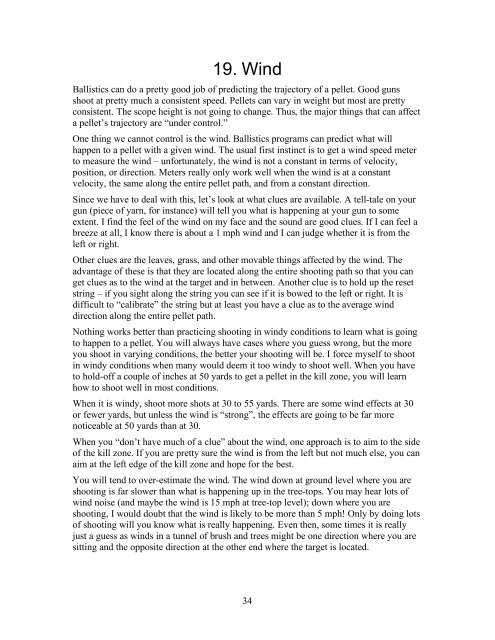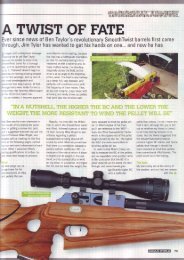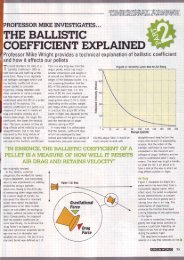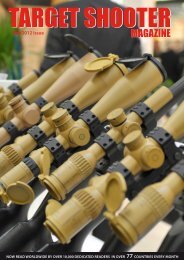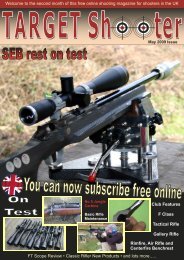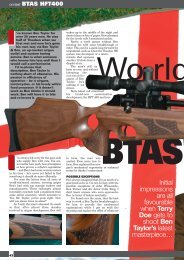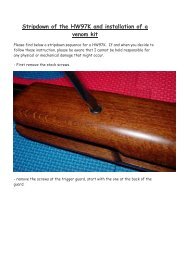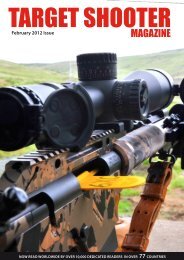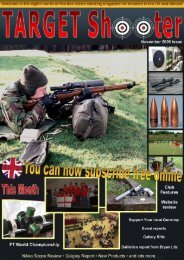Introduction to Field Target
Introduction to Field Target
Introduction to Field Target
Create successful ePaper yourself
Turn your PDF publications into a flip-book with our unique Google optimized e-Paper software.
19. Wind<br />
Ballistics can do a pretty good job of predicting the trajec<strong>to</strong>ry of a pellet. Good guns<br />
shoot at pretty much a consistent speed. Pellets can vary in weight but most are pretty<br />
consistent. The scope height is not going <strong>to</strong> change. Thus, the major things that can affect<br />
a pellet’s trajec<strong>to</strong>ry are “under control.”<br />
One thing we cannot control is the wind. Ballistics programs can predict what will<br />
happen <strong>to</strong> a pellet with a given wind. The usual first instinct is <strong>to</strong> get a wind speed meter<br />
<strong>to</strong> measure the wind – unfortunately, the wind is not a constant in terms of velocity,<br />
position, or direction. Meters really only work well when the wind is at a constant<br />
velocity, the same along the entire pellet path, and from a constant direction.<br />
Since we have <strong>to</strong> deal with this, let’s look at what clues are available. A tell-tale on your<br />
gun (piece of yarn, for instance) will tell you what is happening at your gun <strong>to</strong> some<br />
extent. I find the feel of the wind on my face and the sound are good clues. If I can feel a<br />
breeze at all, I know there is about a 1 mph wind and I can judge whether it is from the<br />
left or right.<br />
Other clues are the leaves, grass, and other movable things affected by the wind. The<br />
advantage of these is that they are located along the entire shooting path so that you can<br />
get clues as <strong>to</strong> the wind at the target and in between. Another clue is <strong>to</strong> hold up the reset<br />
string – if you sight along the string you can see if it is bowed <strong>to</strong> the left or right. It is<br />
difficult <strong>to</strong> “calibrate” the string but at least you have a clue as <strong>to</strong> the average wind<br />
direction along the entire pellet path.<br />
Nothing works better than practicing shooting in windy conditions <strong>to</strong> learn what is going<br />
<strong>to</strong> happen <strong>to</strong> a pellet. You will always have cases where you guess wrong, but the more<br />
you shoot in varying conditions, the better your shooting will be. I force myself <strong>to</strong> shoot<br />
in windy conditions when many would deem it <strong>to</strong>o windy <strong>to</strong> shoot well. When you have<br />
<strong>to</strong> hold-off a couple of inches at 50 yards <strong>to</strong> get a pellet in the kill zone, you will learn<br />
how <strong>to</strong> shoot well in most conditions.<br />
When it is windy, shoot more shots at 30 <strong>to</strong> 55 yards. There are some wind effects at 30<br />
or fewer yards, but unless the wind is “strong”, the effects are going <strong>to</strong> be far more<br />
noticeable at 50 yards than at 30.<br />
When you “don’t have much of a clue” about the wind, one approach is <strong>to</strong> aim <strong>to</strong> the side<br />
of the kill zone. If you are pretty sure the wind is from the left but not much else, you can<br />
aim at the left edge of the kill zone and hope for the best.<br />
You will tend <strong>to</strong> over-estimate the wind. The wind down at ground level where you are<br />
shooting is far slower than what is happening up in the tree-<strong>to</strong>ps. You may hear lots of<br />
wind noise (and maybe the wind is 15 mph at tree-<strong>to</strong>p level); down where you are<br />
shooting, I would doubt that the wind is likely <strong>to</strong> be more than 5 mph! Only by doing lots<br />
of shooting will you know what is really happening. Even then, some times it is really<br />
just a guess as winds in a tunnel of brush and trees might be one direction where you are<br />
sitting and the opposite direction at the other end where the target is located.<br />
34


